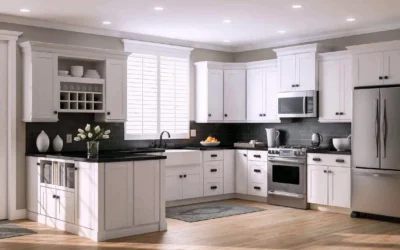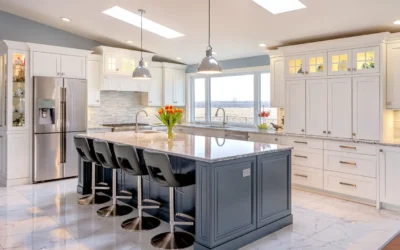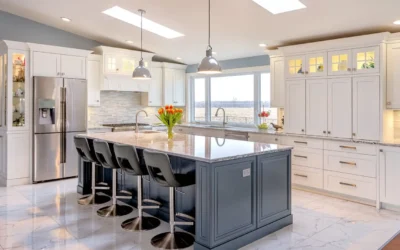If you’re exploring modern cabinet design options, understanding the difference between wood veneer vs. laminate is crucial. The materials and finishes you choose play a significant role in shaping both the aesthetic and durability of your kitchen or living room cabinets. Among the wide variety of finishes available today, wood veneer and laminate have emerged as two of the most popular choices for contemporary interiors.
Both materials offer unique advantages in terms of look, feel, cost, and maintenance. However, choosing the right one depends on your personal style, lifestyle needs, and budget. In this article, we’ll break down the key differences between wood veneer vs. laminate cabinets, giving you the insights you need to make an informed and confident decision for your next home renovation.
What Is Wood Veneer?
Wood veneer is a thin layer of natural wood that is applied to a core material, such as MDF, particleboard, or plywood. This technique allows you to enjoy the beauty of real wood without the cost and weight of solid wood. The natural grain variations and rich textures of wood veneer create an elegant, sophisticated finish that adds warmth and character to any space.
It is often used in high-end cabinetry, particularly in minimalist modern interiors, where sleek design and subtle luxury are essential. Wood veneer cabinets provide an exquisite balance of natural beauty and durability, making them a top choice for homeowners seeking a timeless and refined look.
What Is Laminate?
Laminate is a synthetic material made by bonding layers of paper and resin under high heat, creating a durable and versatile surface. It is available in an extensive range of styles, from wood-look finishes to matte, glossy, or even bold colored options, offering endless design possibilities.
Laminate provides a practical solution for those seeking budget-friendly cabinetry without compromising on style. Its resilience and ease of maintenance make it an ideal choice for high-traffic areas or kitchens that require long-lasting durability.
Whether you’re looking for vibrant colors or a sleek, modern look, laminate is a reliable and affordable option for creating beautiful, functional cabinetry.
Wood Veneer vs. Laminate: for Modern Cabinet Design
When deciding between wood veneer and laminate for your modern cabinet design, it’s important to consider several factors that affect both the aesthetic appeal and functionality of your cabinets.
Each material offers distinct advantages, and your choice will ultimately depend on your budget, desired look, and how much maintenance you’re willing to invest in. Below, we’ll compare the two finishes across key features to help you make an informed decision.
| Feature | Wood Veneer | Laminate |
| Look & Aesthetics | Natural, warm, premium look | Consistent, wide variety of colors/patterns |
| Durability | Moderate; can scratch or fade | Highly durable, scratch and moisture-resistant |
| Maintenance | Requires gentle care and occasional refinishing | Easy to clean and maintain |
| Cost | More expensive due to real wood | Budget-friendly |
| Sustainability | Eco-friendly if sourced responsibly | Depends on brand/material |
| Customization | Unique grain patterns, limited color control | Very customizable in color/texture |
Manufacturing Processes
Wood Veneer
The manufacturing process for wood veneer begins with the selection of high-quality logs. These logs are then debarked and cut into manageable lengths. The wood is typically softened through steaming or soaking to facilitate slicing. There are several methods for slicing wood veneer, including rotary slicing, flat slicing, and quarter slicing, each producing different grain patterns and thicknesses. After slicing, the veneer sheets are dried to the desired moisture content and inspected for quality. Finally, they are trimmed and graded before being packaged for distribution.
Laminate
Laminate manufacturing involves a different process, starting with the creation of a core material, usually particleboard or MDF (medium-density fiberboard). This core is then covered with layers of decorative paper that are impregnated with resin. The layers are pressed together under high heat and pressure, creating a durable surface. After curing, the laminate sheets are cut to size and may undergo additional treatments, such as texturing or finishing, to enhance their appearance and durability. The final product is then packaged and shipped for use in various applications.
Durability and Maintenance: Wood Veneer vs Laminate
When considering durability, wood veneer and laminate differ significantly. Wood veneer, being a thin layer of real wood, offers a natural aesthetic but may be more susceptible to scratches and dents compared to laminate. Laminate, made from synthetic materials, is generally more resistant to wear and tear, making it a preferable choice for high-traffic areas. Maintenance for wood veneer involves regular polishing and careful cleaning to preserve its beauty, while laminate can typically be cleaned with simple household cleaners, requiring less effort to maintain its appearance.
Cost Differences: Veneer and Laminate
In terms of cost, laminate is often more budget-friendly than wood veneer. Laminate is manufactured using less expensive materials, which allows it to be produced at a lower price point. Wood veneer, while offering a premium look and feel, tends to be pricier due to the cost of real wood and the craftsmanship involved in its application. Buyers should consider their budget alongside their design goals when deciding between veneer and laminate.
Environmental Impact: Differences Between Laminate and Wood Veneer
The environmental impact of wood veneer and laminate also varies significantly. Wood veneer, being derived from natural wood, can be more environmentally friendly when sourced sustainably. It contributes to the aesthetic of using natural materials in home design. On the other hand, laminate is often produced from non-renewable resources and may contain harmful adhesives and chemicals. Consumers concerned about eco-friendliness should weigh the benefits of sustainable wood sourcing against the synthetic nature of laminate materials.
Applications
When considering wood veneer vs. laminate, it’s essential to understand their diverse applications in various settings, particularly in kitchen cabinetry, furniture, and interior design. Wood veneer, a thin layer of real wood, is often used in high-end furniture and cabinetry where the look of wood and the feel of real wood are desired. It provides an authentic aesthetic that enhances the warmth of any space. Natural wood veneers are commonly applied in custom millwork and architectural features, especially in luxury homes, owing to their ability to be sanded and refinished, giving them longevity and versatility.
On the other hand, laminate, which is a synthetic material, is widely used for surfaces that require durability and resistance to scratches. Laminate products are often chosen for their affordability and practicality, making them ideal for high-traffic areas like kitchens and commercial spaces. Laminate surfaces can mimic the appearance of wood while being less expensive than veneer, allowing for a broader range of applications without compromising on style.
In terms of construction, laminate is made from layers of engineered wood and resin, which makes it resistant to wear and tear. This synthetic alternative is particularly useful in environments where moisture and heat are present, as laminate cannot be easily damaged. In contrast, while veneer offers the beauty of real wood, it may require more care to maintain its appearance over time.
Ultimately, the choice between veneer or laminate depends on the specific needs of the project, budget considerations, and the desired aesthetic outcome. Understanding the pros and cons of each material can help in making an informed decision that aligns with both functionality and design preferences.
Which Finish Works Best for Modern Cabinet Design?
Choosing the right finish for your modern cabinet design depends on your specific needs, aesthetic preferences, and budget. Both wood veneer and laminate offer distinct benefits, but understanding which material suits your space and lifestyle will help you make a more informed decision. Here’s a guide to help you choose the best option for your cabinetry project.
Choose Wood Veneer cabinets If:
- You want a natural, upscale look that adds warmth and sophistication to your space.
- You’re designing a modern interior with organic elements that require a premium finish.
- Your budget allows for mid-to-high-end materials that bring lasting value and beauty.
Choose Laminate cabinets If:
- You prioritize durability, scratch-resistance, and easy maintenance for a hassle-free experience.
- You need more flexibility in terms of color and pattern options to match various design styles.
- You’re working within a tight budget or are completing a rental project where cost and practicality are key considerations.
Expert Design Tips
To make the most of your wood veneer or laminate cabinetry, consider these expert design tips to elevate your modern space:
- Pair wood veneer with minimalist matte hardware for a high-end Scandinavian look. The natural texture of the wood veneer, combined with sleek matte handles, creates a refined, clean aesthetic perfect for minimalist interiors.
- Use matte or gloss laminate for ultra-modern, sleek cabinetry. Whether you prefer a sophisticated matte finish or a striking glossy surface, laminate offers a contemporary look that complements modern kitchen or living room designs.
- Combine both materials: Consider using wood veneer for upper cabinets and laminate for base cabinets. This combination offers the perfect balance of style and function, giving your kitchen or bathroom a unique design while keeping the lower cabinets durable and easy to maintain.
Pros & Cons Recap Table
When selecting the perfect material for your modern cabinetry, it’s essential to weigh the pros and cons of both wood veneer and laminate. Each finish offers its own set of strengths and weaknesses, and understanding these will help you choose the best option for your space, lifestyle, and budget. Below is a quick summary of the advantages and disadvantages of both materials to guide your decision-making process.
Wood Veneer cabinets Pros:
- Natural, premium look that adds elegance
- Unique grain patterns that bring warmth to your space
- Eco-friendly if sourced responsibly
- High-end aesthetic, perfect for sophisticated designs
Wood Veneer cabinets Cons:
- More expensive than laminate
- Requires occasional maintenance and refinishing
- Prone to scratching and fading over time
Laminate cabinets Pros:
- Highly durable and resistant to scratches and moisture
- Budget-friendly, making it an affordable option
- Easy to clean and maintain
- Wide variety of colors, patterns, and finishes available
Cabinets Laminate Cons:
- Can look less authentic than natural wood
- Less sustainable depending on the brand and materials used
- Limited in achieving natural wood grain patterns
In conclusion, the best choice between wood veneer and laminate depends on your lifestyle, budget, and aesthetic goals. Both finishes play a significant role in modern cabinet design, offering unique benefits tailored to different needs. Whether you’re drawn to the natural elegance of veneer or the practicality and durability of laminate, ensure that your selection enhances both the style and functionality of your home.
FAQs on Veneer vs. Laminate
What is the difference between wood veneer and laminate?
Wood veneer is a thin slice of real wood, while laminate is a synthetic product made to mimic the appearance of wood. Veneer offers the beauty and warmth of real wood, whereas laminate surfaces are designed to imitate the look of wood without the use of natural materials.
Is wood veneer more expensive than laminate?
Generally, wood veneer is more expensive than laminate due to the cost of natural wood. However, the price can vary depending on the type of wood used and the quality of the laminate.
Can you sand wood veneer?
Yes, veneer can be sanded, allowing for refinishing and restoring the veneer surface. In contrast, laminate cannot be sanded as it is a synthetic material.
What are the pros and cons of veneer and laminate?
Veneer pros include its authentic wood grain and ability to be refinished. Cons may include susceptibility to damage if not properly maintained. Laminate is less expensive and resistant to scratches, but it lacks the feel of real wood and cannot be refinished.
Where is wood veneer typically used?
Wood veneer is often used in high-end furniture, cabinetry, and decorative surfaces, providing a sophisticated look with the warmth of real wood.
Is laminate durable?
Yes, laminate is durable and resistant to scratches, making it a practical choice for high-traffic areas such as kitchens. However, it does not have the same longevity as natural wood products.
Can laminate be used in place of wood veneer?
While laminate can imitate the appearance of wood, it does not provide the same authenticity as wood veneer. Depending on the desired look and budget, laminate may be a suitable alternative for certain applications.
What are the layers in laminate products?
Laminate products typically consist of multiple layers, including a backing layer, core layer, and a decorative layer that mimics wood grain. This construction gives laminate its durability and aesthetic appeal.
Still unsure which option is right for your space?
At Kabinetry, our expert team is here to help you choose the perfect cabinet finish that matches your vision and lifestyle. Explore our premium collection of wood veneer and laminate cabinets and get personalized guidance tailored to your design goals.
Contact Kabinetry today to schedule your consultation and bring your modern kitchen to life with style and precision.






